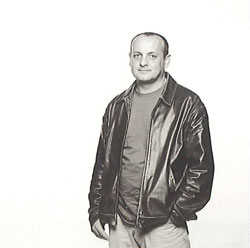José Pedro Croft
José Pedro CroftPorto ¶ 1957
 |
|
| Créditos fotográficos / Photographic credits: Abílio Leitão |
Although he attended the Painting course of the Fine Arts School of Lisbon between 1976 and 1981, it would be as a sculptor that he would achieve his success. During the first phase of his work, in the first half of the 80s, Croft revealed his fascination with the mysterious solemnity of funeral monuments, brought to mind by his stone sculptures/installations. Stone is directly and often transformed by means of industrial tools, which beyond creating a singular corroded appearance also strengthen the desired effect, to wit, that of a ruin. Later, Croft moved towards a technique of stacking the resulting fragments of industrial processing, and created a series of columns, arches, boxes, tumuli, houses and guardhouses that bring to centre-stage spatial relations and varied references to architecture. ¶ Progressively, his work became divested from its metaphorical connections, emerging as rather abstract exercises, which nonetheless live in an intermediate state, between one state and another, an inner space and an outer space, stability and fall. ¶ In the early 90s his reference horizon widened beyond architecture to incorporate objects of daily life. In the period immediately following his sculptures would make use of pre-existing furniture pieces such as stools, chairs and tables. By approaching his own previous monumental quotation as well as these quotidian objects, the artists triggers a short-circuit in his system. However, one must notice that in Croft's work all the references are always dissociated from their original functional and utilitarian context. Croft's objects inhabit a parallel universe. ¶ Throughout the 90s, Croft's oeuvre became consolidated through the dialectics between the radical depuration of the archetype and the intimate presence of the given object. The resulting tension builds a cosmic-like suspense that the sculptor cleverly manages in the utmost equilibrium situations. ¶ In the work developed in the last few years, José Pedro Croft has refined and intensified this line of research in sculpture by incorporating glass and mirrors. These particular materials reaffirm the inference of the spectator's body in the work's perception as they also broaden the problematization of other kinds of perception, specifically those of space and the physicality/evanescence of bodies. In 2006 he held an important itinerant, anthological exhibition in Brazil.
http://cvc.instituto-camoes.pt/biografias-en/jose-pedro-croft-92052.html#sigFreeId9bc98a26de


